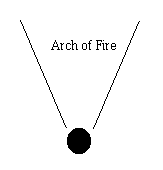An Ambushing force is made up of three
parts: the Command Element, the Assault Element and the Security Element.
In a Small Unit setting, a Team or Element could consist of a single individual.
Weapons with a high rate-of-fire are to be directed at all enemy personnel.
The Command Element is in charge of the Ambush
and holds the Commander, Communications and Medics. The Commander is responsible
for pre-selecting the Ambush Site and deploying all units as well as giving
the Fire and Evacuate orders.
The Assault Element has the task of destroying
the enemy and usually has an Assault Team, a Support Team and a Special
Tasks Team. The Assault Team springs the Ambush while the Support Team
attempts to keep the enemy in the Kill Zone by firing at the outside
edges. The Special Tasks Team is responsible for deploying and firing any
mines, Claymores, etc. In the case of enemy vehicles, anti-armor rounds
and rockets are to be used to disable the vehicles while the Support Team
handles anyone trying to escape the vehicle.
The Security Element provides cover fire to all
areas of approach by enemy re-enforcements as well as any possible enemy
escape routes. Security around the Ambush Site is essential and must be
maintained AT ALL TIMES.




